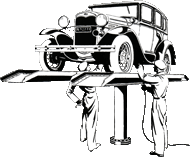
Model A & B
Ford Garage
Exhaust Manifold Warpage
Model A & B exhaust manifolds are well known for warpage and sealing problems and this page explains some of the issues and causes.
The basic manifold design has a couple of shortcomings which lead to problems. First, there are only four attaching studs and there are no attachments at the front or rear extremes of the manifold.
This bolt pattern allows an uneven clamp load which can allow leakage at the unclamped ends, as well as differential movement to the block with manifold expansion and contraction during temperature changes.
Second, the exhaust outlet is located at the far rear, rather than at or near the center of the manifold.

 fordgarage.com
fordgarage.comThe position of the outlet at the rear means that all four cylinders' exhaust heat is transferred and saturated at the rear port area. In contrast, the area at the number one port 'benefits' from cooling air from the radiator fan and the heat saturation from only the number one cylinder.
This uneven distribution of heat along the manifold, combined with a less than ideal attachment stud quantity and pattern, allows the manifold to expand and contract unevenly during heating and cooling cycles.
Additionally, the weight of the muffler is suspended from the rear of the manifold, and adds an ever-present downward force on the hottest portion of the manifold.
Now just for fun, throw in the fact that a great many Model A's also do not have proper ignition timing, and have owners who like to idle them at very low rpm's, and who tend to drive with the spark too far retarded.
Any late timing condition causes fuel to continue burning and releasing heat after passing into the exhaust manifold. This adds tremendous heat energy into the casting and actually can make the casting glow red hot, as many people have experienced.
After experiencing these extreme heat cycles, the exhaust manifold will warp, and can additionally distort the intake manifold and its sealing.
The distortion of the exhaust manifold will allow outside air and oxygen to be drawn through the exhaust leak, and further combust the unburned fuel in the exhaust and elevate the temperature and warpage!
A leak at the adjacent intake port will cause a vacuum leak and cause running and carburetion problems with the engine.


Shown above is the effect of late ignition timing and a rich fuel mixture, probably along with leaking gaskets!
Model A Exhaust Manifold Design

 fordgarage.com
fordgarage.comShown above is the droop or sag at the number 4 port on a Model A manifold. The first three ports remain in line, but the number 4 port has drooped significantly.
This type of warpage is the primary failure. Manifolds do not seem to change shape or warp in the plane of the machined gasket surface. Re-surfacing the gasket surface is really of little value in addressing the typical warped manifold.
Model B Exhaust Manifold Design

 fordgarage.com
fordgarage.comThe droop or sag at the number 4 port on a Model B manifold. The first three ports remain in line, but the number 4 port has dropped some.
Manifold sag at the rear port by more than 1/8 inch is a good signal to start looking for a replacement manifold, or be prepared to deal with exhaust and intake leaks at that area.
More related information on Ford Garage:
- For more Model A & B related information, use the Site Search box at the top or bottom of this page.
- Model A & B Exhaust Manifold Comparison
Vince Falter
January 2004

